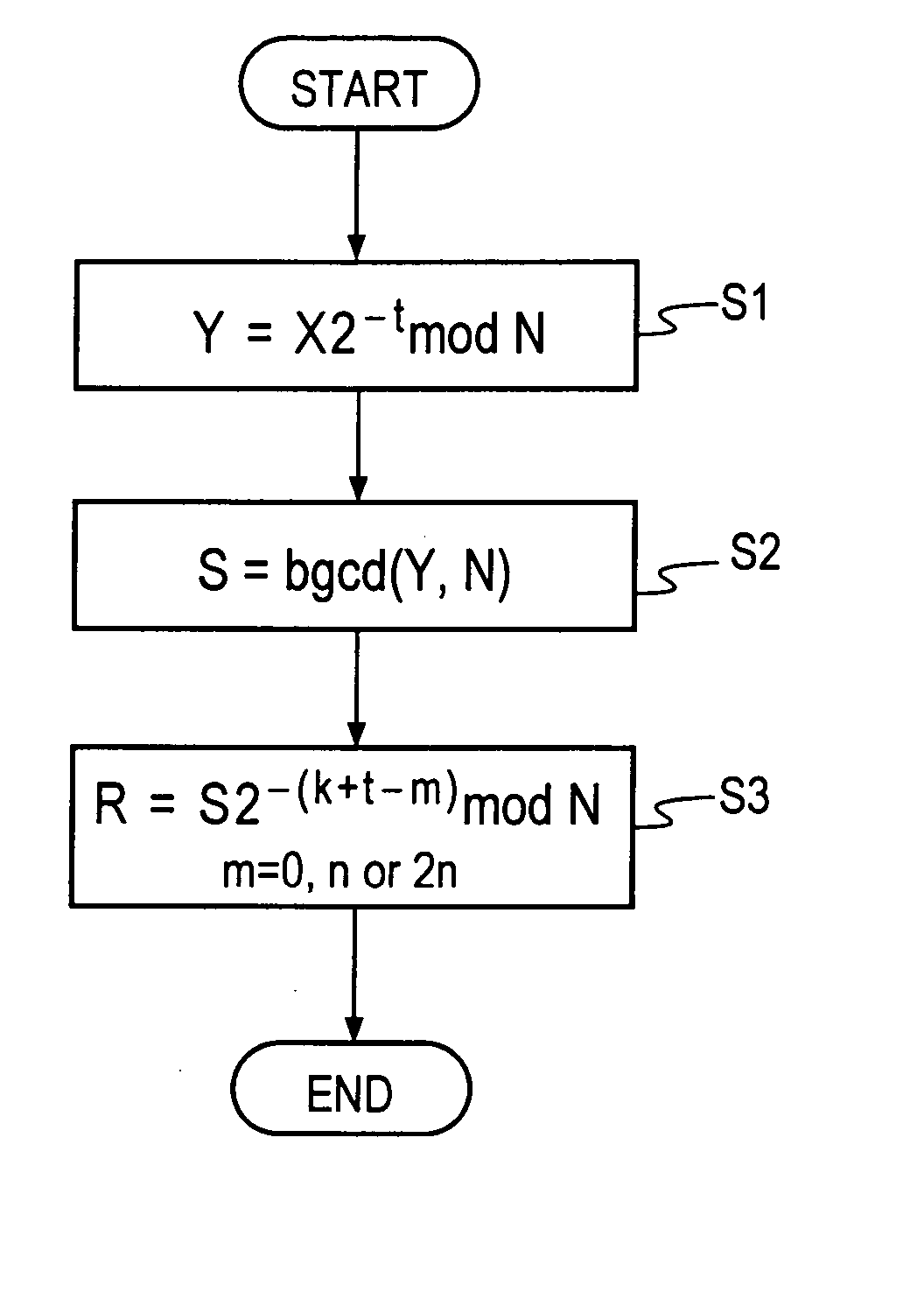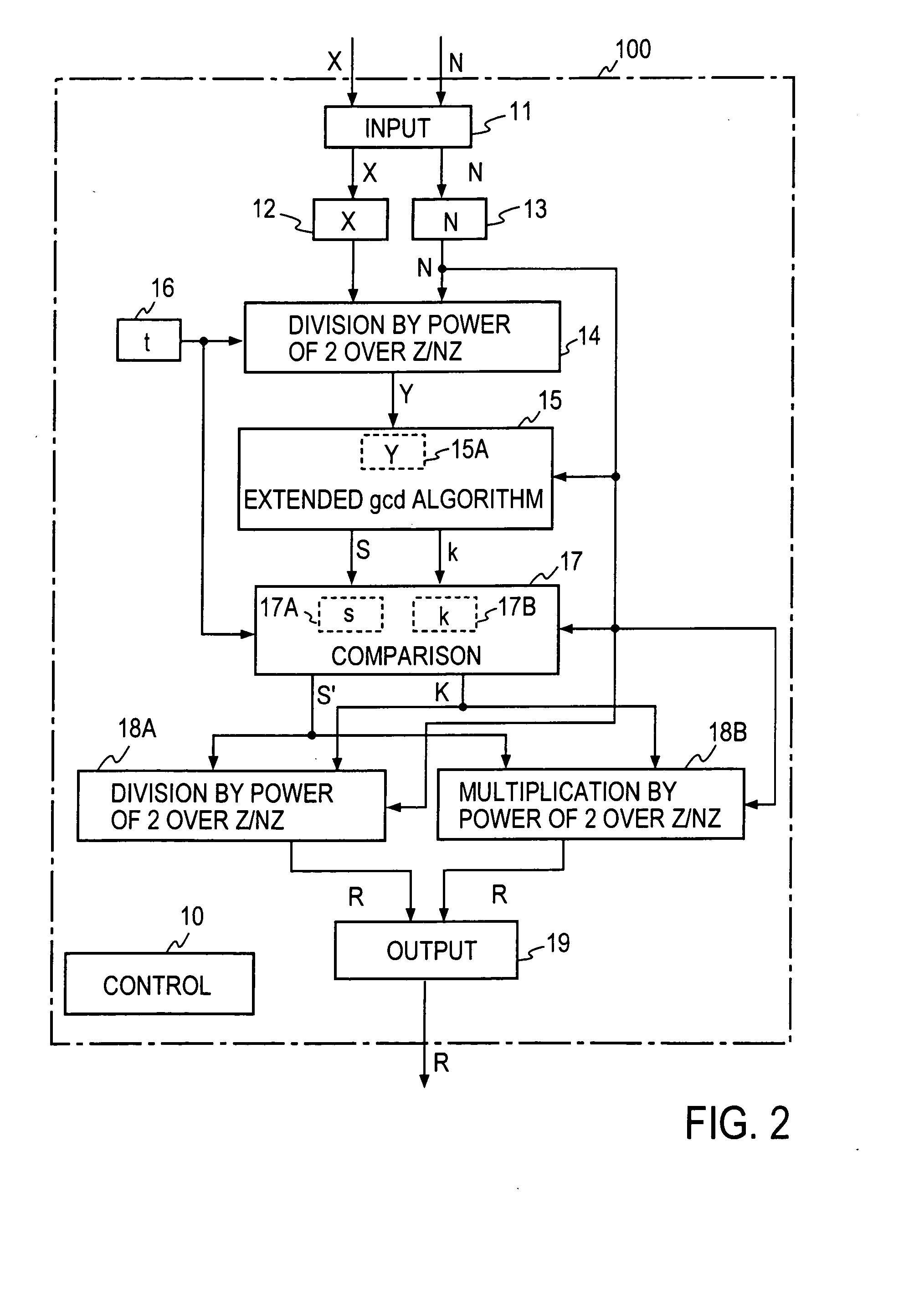Method and apparatus for modular inversion for information security and recording medium with a program for implementing the method
- Summary
- Abstract
- Description
- Claims
- Application Information
AI Technical Summary
Benefits of technology
Problems solved by technology
Method used
Image
Examples
first embodiment
Flowchart for Montgomery Inversion over Z / NZ
FIG. 1 is a flowchart for Montgomery inversion over Z / NZ according to the present invention.
This procedure is to calculate an output value X−122n mod N (where n is the size or bit length of N) from input values X, N (odd).
An appropriate value for t is determined according to the size of the input N and the velocity ratio between multiplication by power 2 and inverse operation thereto by power of 2. It is preferable that t be approximately in the range of 0.64n+20 to 0.54n−20. From the view point of faster calculation, it is particularly preferable that the value t be an integral multiple of, for example, 16 which is the number of bits to be processed on hardware of the processing unit at a time. Step S1: First, calculate Y by the following equation.
Y=X2−t mod N Step S2: Next, perform an extended binary GCD algorithm for Y and N, and obtain S and k″ as output values by the following equation.
S=gcd(Y,N)=Y−12k″ mod N (12) Step S3:...
second embodiment
Steps 1 and 3 of the modular inversion according to the first embodiment of the present invention have been described to calculate division or multiplication by power of 2. A mere division by 2k can be calculated by a k-bit-shift operation. For example, in the case of dividing by 23 a number 40 (in decimal representation), which is 101000 in binary representation, a three-bit right shift operation is performed. This provides 101 in binary representation, allowing ease in finding 5. However, a mere k-bit-shift operation is not enough to calculate division by 2k on the Z / NZ like the calculation in the division part 14 or 18 in FIG. 2. A conventional solution to this problem is to execute the following process, for example, in the case of calculating an output S2−k mod N from inputs S, k and N (odd).
(a) If the input value S is divisible by 2, then a calculation S / 2 is performed and the calculation result is newly set as S′.
(b) If the input value S is not divisible by 2, then a cal...
third embodiment
The process of Step 2 in the Montgomery inversion in the first embodiment of the invention is an extended binary GCD calculation process as mentioned previously. The third embodiment is directed to a method and apparatus for efficient extended binary GCD calculation in the modular inversion by the present invention.
Conventional methods for obtaining the greatest common divider (GCD) are (1) Euclidean algorithm, (2) binary GCD algorithm and (3) algorithm L. The algorithm L is a method intended to improve the efficiency of the Euclidean algorithm for large numbers.
(1) Euclidean Algorithm
The Euclidean algorithm utilizes the fact that when setting
Xi=QiYi+Ri (30)
the following equation holds true:
gcd(Xi, Yi)=gcd(Yi, Ri) (31)
Xi and Yi are obtained from X0 and Y0 by repeated application of Eq. (30) with
Xi+1=Yi, Yi+1=Ri (32)
Since
gcd(X0, Y0)=gcd(X1, Y1)= . . . gcd(Xj, 0)=Xj (33)
gcd(X0, Y0) can be obtained using Eq. (31). (See D. E. Knuth, “The Art OF Computer Programmin...
PUM
 Login to View More
Login to View More Abstract
Description
Claims
Application Information
 Login to View More
Login to View More - R&D
- Intellectual Property
- Life Sciences
- Materials
- Tech Scout
- Unparalleled Data Quality
- Higher Quality Content
- 60% Fewer Hallucinations
Browse by: Latest US Patents, China's latest patents, Technical Efficacy Thesaurus, Application Domain, Technology Topic, Popular Technical Reports.
© 2025 PatSnap. All rights reserved.Legal|Privacy policy|Modern Slavery Act Transparency Statement|Sitemap|About US| Contact US: help@patsnap.com



